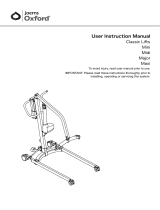Tools Required
• 5mm hex key
• 6mm hex key
• 8mm A/F combination spanner
• 2 x 10mm A/F combination spanner
• 14mm A/F combination spanner
• 16mm A/F combination spanner
• 0-50Nm range torque wrench
• 17mm A/F socket
• Socket wrench
• Medium weight hammer
• Large (7mm) at blade screwdriver
Corner Castors
NOTE: To aid removal, it is recommended the frame is removed as detailed in the ‘Frame Removal’
procedure.
Removal
1. Unscrew the castor spindle using 2-off 10mm A/F combination spanners.
2. Withdraw the spindle from the castor wheel.
3. Remove the castor wheel from the castor swivel bracket.
4. Unscrew the castor swivel bracket retaining nut using a 17mm A/F socket and socket wrench.
5. Withdraw the castor swivel bracket from the M10 retaining stud.
6. Tap out the M10 retaining stud from the base using a medium weight hammer.
Replacement
1. Insert the M10 retaining stud through the square hole in the base.
NOTE: Ensure the square shank of the retaining stud locates correctly in the square hole in the base.
2. Tap the M10 retaining stud into the base using a medium weight hammer.
3. Unscrew the castor spindle of the replacement corner castor using 2-off 10mm A/F combination
spanners.
4. Withdraw the spindle from the castor wheel.
5. Remove the castor wheel from the castor swivel bracket.
6. Correctly locate the castor swivel bracket over the M10 retaining stud.
7. Screw the M10 retaining nut onto the M10 retaining stud and tighten to 25Nm using a 17mm A/F
socket and socket wrench.
8. Correctly position the castor wheel between the castor swivel bracket and insert the castor spindle
through the swivel bracket and castor wheel.
9. Screw the M6 nut onto the castor spindle and tighten to 15Nm using 2-off 10mm A/F combination
spanners.
10. Replace the frame as detailed in the ’Frame Replacement’ procedure.
Service / Repair Schedule














